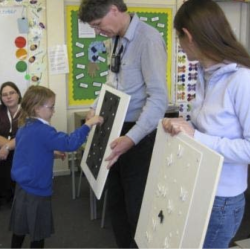Source Institutions
Source Institutions
Add to list Go to activity
Activity link broken? See if it's at the internet archive

In this activity (p.5-6 of PDF), learners investigate natural selection. Learners discover that natural selection, which takes place over decades, can lead to altered populations within a species. Use this activity to explain the role of pollution and how humans can impact populations as well as compare natural selection to the development of antibiotic resistance in bacteria, which occurs much more quickly.
- Under 5 minutes
- 10 to 30 minutes
- $5 - $10 per group of students
- Ages 8 - 11
- Activity, Demonstration, Lesson/Lesson Plan
- English
Quick Guide
Materials List (per group of students)
- Peppered moth template (p.17 of PowerPoint presentation)
- Black and white sheets of material (craft foam) from which can be cut into moth-shapes; need enough to make 10 moths of each color
- Background sheets: large 45 x 30 cm, sheets of the same/similar material colors as the moths (black and white)
- Hook and loop fastener (Velcro)
- Boards (polyboard about 1 cm thick; light, easy to stick pins in)
- Pins
- Silhouettes or pictures of different moth species
- Pieces of coal (optional)
Subjects
-
Life Sciences
-
Diversity of Life
- Animals
-
Ecology
- Populations
- Human Impact
-
Evolution
- Mechanisms of Evolution
-
Diversity of Life
-
The Nature of Technology
-
Technology and Society
- Impacts of Technology
- Technology and the Environment
-
Technology and Society
Informal Categories
- Animals
- Nature and Environment
Audience
To use this activity, learners need to:
- see
- see color
- be mobile
- touch
Learning styles supported:
- Involves hands-on or lab activities
Other
Components that are part of this resource:
This resource is part of:
Access Rights:
- Free access
By:
- Cavanagh, Dave ; Pickup, Nikki ; Cavanagh, Laura
Rights:
- All rights reserved, Professor Dave Cavanagh, Dr Nikki Pickup and Laura Cavanagh, Institute for Animal Health,
